By Gerda Krogslund, Middletown Senior Master Gardener Volunteer
This article appeared in the April 2021 Issue of Gardening in Orange County.
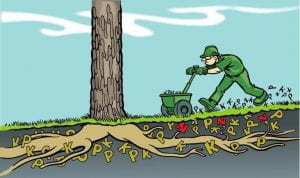 It is spring and everyone wants to go outside and apply fertilizer to their plants, because that’s what you do in the spring. However, overfertilizering your plants is not only a waste of time and money, but it can also damage your plants and harm the environment. If you already incorporated lots of compost and other organic material into your soil every year, your soil is probably doing well. So before you add fertilizer or any other soil amendments to your garden, I encourage you to get a soil test.
It is spring and everyone wants to go outside and apply fertilizer to their plants, because that’s what you do in the spring. However, overfertilizering your plants is not only a waste of time and money, but it can also damage your plants and harm the environment. If you already incorporated lots of compost and other organic material into your soil every year, your soil is probably doing well. So before you add fertilizer or any other soil amendments to your garden, I encourage you to get a soil test.
Once you’ve gotten your soil tested, confirmed that you need fertilizer, and are ready to add some fertilizer, there are many things to consider, so lets take a look at a few of them.
What is a soil amendment?
Soil amendments are substances added to the soil to improve plant growth. Fertilizers the most common type of soil amendment and their main purpose is to supply nutrients to plants. Soil conditioners are soil amendments that are mixed into the topsoil to improve soil structure. Improving the structure of your soil will allow water and air movement in the soil and help with plant root growth. Compost is considered a soil conditioner as it improves the soil structure with the added benefits of slowly releasing nutrients to the plants and increasing bacterial and fungal activity. Other soil amendments include biostimulants and pH adjusters.
What do the numbers mean on a bag of fertilizer?
Fertilizers contain the primary macronutrients needed by plants: nitrogen (N), phosphorus (P), and potassium (K) . The three numbers on a bag of fertilizer represent the percentage (by weight) of NPK found in that bag. For example, the numbers on a 50-lb. bag of 10-6-4 fertilizer contains 10% N (5 lbs.), 6% P (3 lbs.), and 4% K (2 lbs.) The remaining 80% (40 lbs.) of the mixture is made up of secondary nutrients like calcium, magnesium and sulfur, trace elements, and fillers that make it easier to spread.
Each macronutrient is essential to healthy plant growth. Nitrogen (N) is used for to promote foliar growth. Phosphorus (P) supports the plant’s roots and reproductive system including flower and fruit development. Potassium (K) is important in root development and for overall plant health, including disease and stress resistance.
Knowing what each number represents can help you decide which fertilizer is best for your specific situation. If you are looking for a fertilizer to enhance flower production for your annual and perennial flowers, you would choose a fertilizer with more phosphorous like a 5-10-5. If you are looking to encourage foliar growth for leafy green vegetables, evergreens, or shrubs, you would look for a fertilizer with more nitrogen or a higher first number such as 10-6-4. Understanding the number will help you avoid applying the wrong kind of fertilizer. If you add too much nitrogen to a tomato plant, you might have a lush green leafy plant with very few flowers. The same holds true for root crops such as carrots; too much nitrogen will produce beautiful leaves, but smaller roots.
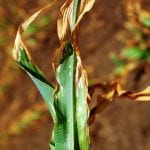
Remember chemical fertilizers contain salts. Apply too much, and the plant cells will begin to dehydrate and collapse. Too much fertilizer will burn plant leaves and roots, and sometimes even kill the plant. This is called fertilizer burn. If you suspect fertilizer burn, use plenty of water to flush out excess fertilizer and prune out any burned leaves.
Should I use solid or liquid fertilizer?
Whether you use solid or liquid fertilizer, you should always water your plants before application. This will help the roots absorb nutrients better and mitigate the risk of root burn.
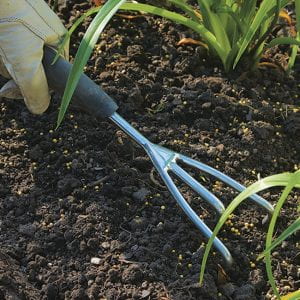 A common type of solid fertilizer is granular fertilizer. Granular fertilizers can be broadcast by hand and then scratched into the top 4-6 inches of soil. For large areas like lawns, a mechanical spreader can be used. Moisture is needed to break down solid fertilizers and make nutrients available to plants. After application, carefully wash any fertilizer granules off of the foliage of your plants and water to release the nutrients.
A common type of solid fertilizer is granular fertilizer. Granular fertilizers can be broadcast by hand and then scratched into the top 4-6 inches of soil. For large areas like lawns, a mechanical spreader can be used. Moisture is needed to break down solid fertilizers and make nutrients available to plants. After application, carefully wash any fertilizer granules off of the foliage of your plants and water to release the nutrients.
Many solid fertilizers are quick release meaning that the nutrients are available immediately after application. There are also slow-release fertilizers that come in capsule forms and dissolve as they get wet. Since the capsules are made to break down at different rates, a single application can last over several months.
Water soluble fertilizers are sold as liquids or powders which you dissolve in watering before applying. These are great for fast-growing plants because the fertilizer is applied directly to the leaves and plants take up nutrients more efficiently through the leaves than through roots. Nutrients are absorbed quickly and rarely burn the plants. For large areas you can use hose-end sprayer fertilizers which come in containers that connect to the end of your hose and can be easily sprayed over your plants. A drawback to liquid fertilizers is that they must be applied more frequently as they can move quickly through the soil especially if it rains after an application.
Should I use organic or inorganic fertilizer?
Organic fertilizers are derived from plant and animal sources or a mined mineral such as rock phosphate. Liquid organic fertilizers include compost tea, fish emulsion, and seaweed. Dry organic fertilizers include manure, blood meal, bone meal, and cottonseed meal. Organic fertilizers usually contain low concentration of nutrients that are slowly released into the environment as they are broken down by soil microbes. Because of this, they are much less likely to cause fertilizer burn, and do not harm beneficial microbes in the soil.
Inorganic fertilizers or synthetic fertilizers are usually less expensive than organic ones and give quick results. However there are draw backs. They can cause fertilizer burn and if application rate or timing is off, there is a high chance of fertilizer runoff which can have detrimental effects on the environment. Many synthetic fertilizers also contain high concentrations of salts, which can cause fertilizer burn and can harm soil microbes.
How and when should I apply fertilizer?
Home gardeners have a tendency to overfertilize, that is why soil tests are so important. Remember if your beds are rich in organic material you may not need any fertilizer, that holds true for annuals, herbaceous perennials, and vegetables. New gardens low in organic matter may need to be fertilized in early spring, usually a 5-10-10 will suffice, but make sure to test your soil to see what your soil needs.
Herbs are a special case. Many herbs such as basil, thyme, rosemary, oregano, and lavender, grow best on sunny dry sites in sandy soil. Heavy applications of fertilizers or organic matter may lower the plant’s essential oil content and encourage root and stem rot diseases.
Healthy mature trees usually do not need fertilizer as they benefit from turf fertilization as well as the decomposition of grass clippings and fallen leaves. Shrubs that are surrounded by turf usually do not require additional fertilizer either. For those shrubs whose growth is slow, top-dress their beds with compost or apply a balanced fertilizer like 5-10-5 in early spring or in late fall. Don’t fertilize your perennials, trees and shrubs in late summer or early fall or you may encourage a flush of new growth that will not have time to harden off before the winter.
What about my lawn?
When it comes to lawns, the best time to apply fertilizer is in September. If you have a high use lawn it may need a second fertilizer application in May. Returning grass clipping to your lawn can reduce the need for nitrogen fertilizer by 25 – 50 %. Note that New York State Runoff Law restricts the use of fertilizer containing phosphorous unless you are establishing a new lawn or have the results of a soil test that indicate your lawn does not have enough phosphorous. Check out Cornell’s turf website for more information about how and when to feed your lawn. 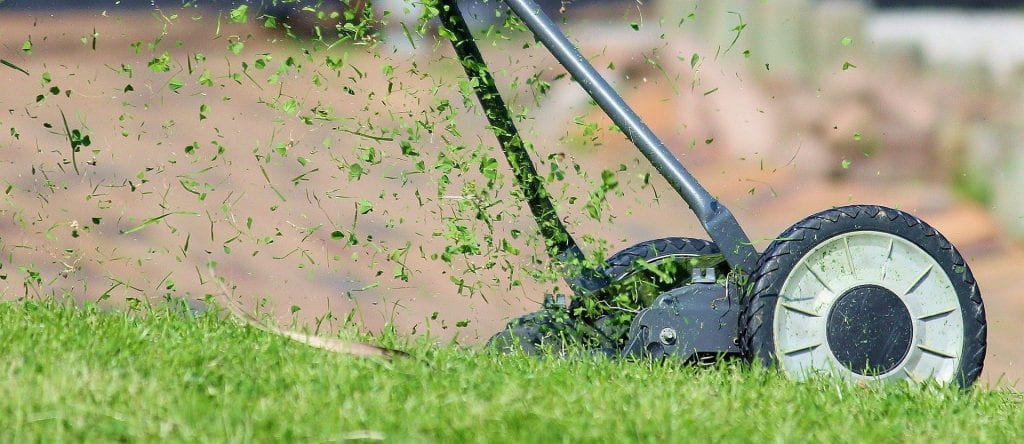
What about soil pH?
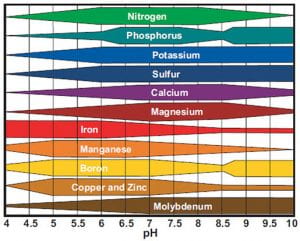
Soil pH is a measure of the hydrogen ion activity in the soil. The scale of measuring acidity or alkalinity contains 14 divisions known as pH units. The pH value of 7 is neutral with values below 7 are acidic and values above 7 are basic or alkaline. With some exceptions most plants do best when the soil pH is in the 6.0 – 7.0 range. pH affects the availability of nutrients in the soil. As a result, plants in soil with very high or very low soil pH will show symptoms of nutrient deficiency.
Of course some plants prefer acidic or alkaline soil. Azaleas like an acidic soil and may develop yellow leaves if the pH is over 7.0. Blueberries do best in an acidic soil in the 4.5 – 5 range.
You can change the pH of the soil, but it is usually a slow process and may require repeat treatments. Adding lime to the soil will increase the pH and adding ammonium sulfate, iron sulfate or elemental sulfur will lower the pH. Liming is best done in the fall to allow time for it to change the pH. Instead of trying to change the pH of your soil, it is easier to choose plants that are adapted to the existing conditions. This is the principle of selecting the right plant for the right site. Changes to pH are short term and annual pH tests are recommended to determine what needs to be done to maintain desired soil pH.
 Remember that the best way to improve plant growth is the regular incorporation of organic matter or compost in the soil for good soil structure. If you do decide to buy soil amendments, always read the label, apply the recommended amounts and use proper personal protective equipment like gloves and masks. Happy gardening!
Remember that the best way to improve plant growth is the regular incorporation of organic matter or compost in the soil for good soil structure. If you do decide to buy soil amendments, always read the label, apply the recommended amounts and use proper personal protective equipment like gloves and masks. Happy gardening!
Resources
Correcting Soil pH – Cornell Cooperative Extension
Fertilizer Basics – University of Maryland Extension
Fertilizing your Lawn – Cornell Turfgrass
Fertilizing Trees and Shrubs – University of Maryland Extension
Lawn Fertilizer – NYS Nutrient Runoff Law – NYS Department of Environmental Conservation
Organic Matter and Soil Amendments – University of Maryland Extension
Soil Testing for Home Gardeners – Cornell Cooperative Extension
